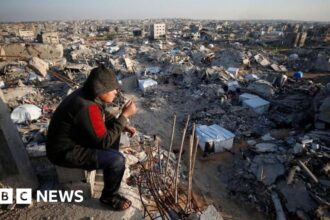The Center for Participation and Engagement leads an important initiative titled, “Mitigation of Climate Change In Guria – Civic Activism for a Clean River Supsa.” The project, which is funded through the grants competition of Georgia Climate Action Project supported by EU and implemented CENN, aims at addressing climate change impacts in Guria by assessing pollution risk in the Supsa River Basin and introducing prevention mechanisms through citizen participation and awareness-raising.
The project includes a number of key measures, including public picnics, cleaning campaigns, social campaigns documenting landfills, educational lessons, a drawing contest to inspire youth and recommendations to local authorities for improving waste management. The initiative culminated with a discussion forum that focused on environmental challenges and solutions in the Guria Region.
GEORGIA NOW spoke with Zurab Nasaraia, a doctor of public administration and associate professor at the Technical University who is the Project Director, to gain a deeper understanding of the project.
What motivated you to focus on this initiative?
I would like to begin the interview by sharing some important news. The Center for Participation and Engagement has become a member in the European Environment Bureau with the support of EU-funded Georgia Climate Action Project. This is important because one of the main objectives we have in the Guria Region is to implement best practice in sustainable development and promote citizen engagement.
In order to achieve green status for our region, we developed the concept “Green Guria” during the development of Guria’s regional strategy. This concept envisions a climate-friendly atmosphere, new tourism opportunities and local agricultural development. It also includes active community involvement. This concept guided our team in focusing on this initiative. It led to the planning, implementation and completion of the project “Climate Change Mitigation in Guria-Civic Activism for Clean Rivers”.
What was the biggest obstacle you faced in cleaning up the Supsa River, its banks and the villages of Lesa and Askana during the clean-up effort? How did the community react?
Georgia, in particular the Guria region is not an exception. The waste at landfills is not always separated or processed. This is both unjustifiable and environmentally harmful. This situation is harmful to the environment and public safety, especially if waste is dumped into rivers by the community.
Our research focused on the Supsa River which flows through the villages of the area. The Supsa River has a unique history because it originates from the Guria Mountains and flows through all three municipalities in the region. During our research, we identified both natural and man-made hazards that contribute to waste pollution of the river. We found significant accumulations of agricultural and domestic waste along the riverbed as well as illegally constructed landfills near the riverbank. Illegal mining and excessive inert materials were also evident. The riverbed is altered with hollows and bank erosion. Plastic and household waste pose a variety of dangers to local residents. Plastic particles, for example, can enter our bodies via drinking water or wash ashore and create health risks for beachgoers.
It is important to emphasize the enthusiasm of local residents in improving the situation. The project’s activities have been a great way to motivate and engage the community. Their active participation in clean-up actions and awareness-raising campaigns–such as the “Samokalao Picnics”–demonstrates that this is just the beginning. We prepared a comprehensive plan and recommendations to address these issues.
What role did civic education and local teachers have in educating the students about the importance to protect the Supsa River?
Our efforts were not possible without the involvement of teachers and students. Teachers, including those who specialize in civic education, were actively involved in the project. We held open lessons in nature and motivational competitions, and displayed the artwork of students. The winners were announced to encourage participation. The increased interest and engagement among the students encouraged their parents to participate in the cleaning activities.
It is important to teach children about hygienic practices and to instill a love of nature at a young age. I believe that civic education will play a vital role in mitigating future risk.
What was the outcome of the discussion forum “Green Future of the Guria Region?” What environmental challenges and solutions have been identified?
The forum “The Green Future of Guria”, which was held in Guria, provided a platform for highlighting the role and responsibility of each individual when it comes to addressing environmental issues. In a mountainous area like Guria it is especially difficult to build an effective waste-management system. It requires the involvement of each individual, as well as the cooperation of different agencies, organizations and institutions.
Participants noted that rural areas face particular challenges in implementing a waste-management system due to issues with waste collection, and lack of equipment. Lack of garbage bins causes waste to be thrown in rivers, valleys, or makeshift landfills. Guria already has a limited amount of land, so adding landfills will result in an inefficient use of land and environmental degradation.
The forum participants agreed that it was important to implement the EU Mayor’s proposed methodology “Waste Management Technologies in Regions” which could assist local authorities in setting up a proper waste system that encompasses prevention, placement and sorting as well as preparation for reuse and recycling.
What are the long-term goals for preventing pollution and ensuring sustainable waste disposal efforts in the Supsa River Basin?
We developed new routes for waste collection and, in collaboration local governments, we installed more garbage bins. We developed recommendations that have been incorporated into the medium-term action plans of municipalities. We also conducted awareness campaigns in 21 villages along the Supsa River. Local populations and municipal services participated actively; the mayor of Lanchkhuti joined these activities. All illegal dumps identified were cleared and banners urging the community to “Protect a Clean Supsa” were installed. With the help from municipal services, we removed accumulated household garbage from the riverbed, which caused artificial sedimentation, posing risks during floods.
To achieve sustainability, it is important to implement the following key activities: identifying, describing and inventorying landfills in the region, closing and renovating landfills, ensuring active participation of the five-year municipal plan, and increasing community awareness about waste sorting and recycle. In tourist areas, we plan to increase the frequency of waste collection and purchase smaller, more maneuverable machinery for hard-to reach locations. This is not a complete list.
CPC is actively working with donors to secure the funding necessary to implement waste management technologies in Guria. We believe it is important to develop mechanisms that encourage waste prevention, reuse and recycling at the municipal level. Experts suggest that we create effective mechanisms to reduce the costs associated with waste disposal, such as implementing “Pay as You Throw”, which could increase taxes for unsorted waste.
How will you involve the local youth in future environmental activities, and how do you plan to do so?
The Center for Participation and Engagement uses innovative participatory democracy instruments, such as “craft Picnics”, citizen ensembles, and electronic budgeting, that are particularly appealing and available to young people. We are confident that the mechanisms will engage vulnerable groups and local communities.
We aim to involve more citizens in environmental activities and accelerate the realization of “Green Guria”.
CENN has implemented a four-year program, the Georgia Climate Action Program with the financial assistance of the European Union, since 2021. The project is being implemented in four regions: Kakheti Imereti Guria Racha-Lechkhumi. Its goal is to increase the civil society’s engagement in developing and implementing climate change policies.
The Center for Participation and Engagement is one of the winners in the competition that CENN organized as part of this project. The project has awarded 9,000 EUROS each to 20 organizations for innovative initiatives focusing on climate adaptation and mitigation in focus regions.
Read More @ georgiatoday.ge













